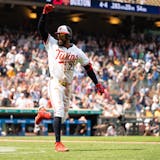What was the State Fair like 100 years ago? Sept. 6, 1922, was State Pioneers' Day. Over 500 pioneers and family members showed up, and the morning paper said they expected Uncle John Dabney, of Taylors Falls, Minn. He was 103. Grandmother Truax, a spry 101, was due, as well. Neither showed up.
But Cal did.
The vice president of the United States, Calvin Coolidge, appeared at an event that might have scarred him so profoundly it altered his entire public persona. But we'll get to that in a bit.
He wasn't the first veep to appear at the fair. Teddy Roosevelt brought his sunny, squinty mug to the fair in 1901, and spoke a phrase that entered the pantheon of Famous Utterances: "Speak softly, and eat something on a big stick."
Wait; that's not right. But it was something like that, and everyone knew what he meant — be moderate in your dealings with other nations, in hopes of solving things by civil means, but failing that, be prepared to wallop the other guy. It's certainly better than "Scream your head off at the other dude, and then when he's all freaking out, get out two big sticks, one in each hand, and start wailin' on him."
On the other hand, if you're sitting down for negotiations, and you're speaking in calm, reasoned tones, someone is going to notice that you've brought a stick. Especially if it's a big stick. Maybe you smuggled it in somehow, slid into a pants leg. Perhaps after TR's speech, they started patting down soft-spoken people for big sticks, and the next few years there were signs that said, "Big sticks are prohibited from the premises," or "This is a stick-free zone."
It's astonishing that there are no food vendors that capitalize on this speech and sell Bully Braised Bull Moose on a Big Stick.
Anyway. TR was out of the picture by 1922; Warren Harding was president. Coolidge was dispatched to regale fairgoers with the accomplishments of the administration. Two problems: Many people in the bleachers were there for the auto races, not some guy droning on about politics. And it was about 98 degrees.


